Assessment, Preparation, Observation, Planning and Implementation for Early Childhood Education
VerifiedAdded on 2022/11/10
|12
|2577
|227
AI Summary
This document provides insights on assessment, preparation, observation, planning and implementation for early childhood education. It covers indoor and outdoor activities, visual arts, music, and dramatic play experiences for children aged 3-6 years. The document also emphasizes the importance of creating a learning environment that reflects appreciation and awareness of diversity.
Contribute Materials
Your contribution can guide someone’s learning journey. Share your
documents today.
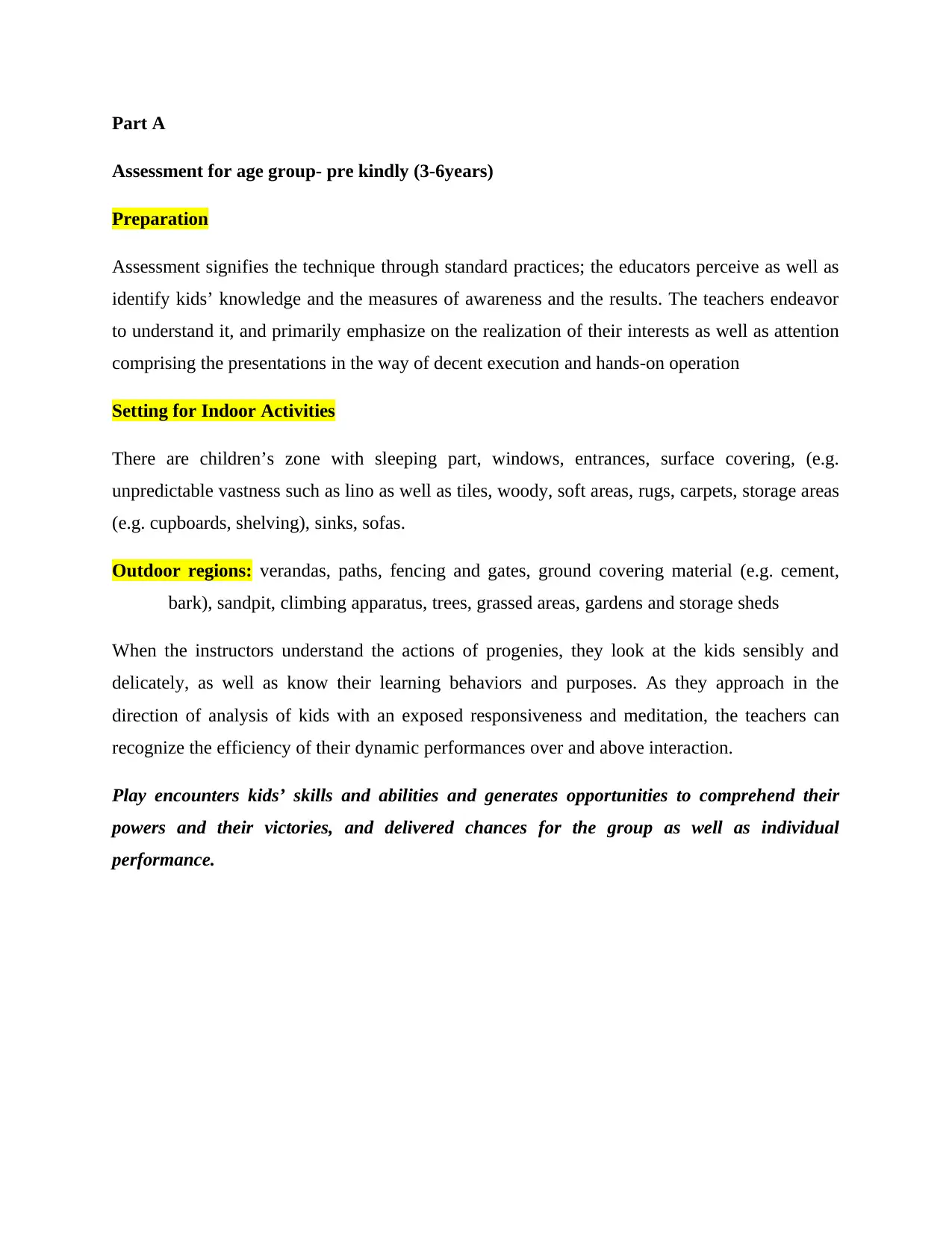
Part A
Assessment for age group- pre kindly (3-6years)
Preparation
Assessment signifies the technique through standard practices; the educators perceive as well as
identify kids’ knowledge and the measures of awareness and the results. The teachers endeavor
to understand it, and primarily emphasize on the realization of their interests as well as attention
comprising the presentations in the way of decent execution and hands-on operation
Setting for Indoor Activities
There are children’s zone with sleeping part, windows, entrances, surface covering, (e.g.
unpredictable vastness such as lino as well as tiles, woody, soft areas, rugs, carpets, storage areas
(e.g. cupboards, shelving), sinks, sofas.
Outdoor regions: verandas, paths, fencing and gates, ground covering material (e.g. cement,
bark), sandpit, climbing apparatus, trees, grassed areas, gardens and storage sheds
When the instructors understand the actions of progenies, they look at the kids sensibly and
delicately, as well as know their learning behaviors and purposes. As they approach in the
direction of analysis of kids with an exposed responsiveness and meditation, the teachers can
recognize the efficiency of their dynamic performances over and above interaction.
Play encounters kids’ skills and abilities and generates opportunities to comprehend their
powers and their victories, and delivered chances for the group as well as individual
performance.
Assessment for age group- pre kindly (3-6years)
Preparation
Assessment signifies the technique through standard practices; the educators perceive as well as
identify kids’ knowledge and the measures of awareness and the results. The teachers endeavor
to understand it, and primarily emphasize on the realization of their interests as well as attention
comprising the presentations in the way of decent execution and hands-on operation
Setting for Indoor Activities
There are children’s zone with sleeping part, windows, entrances, surface covering, (e.g.
unpredictable vastness such as lino as well as tiles, woody, soft areas, rugs, carpets, storage areas
(e.g. cupboards, shelving), sinks, sofas.
Outdoor regions: verandas, paths, fencing and gates, ground covering material (e.g. cement,
bark), sandpit, climbing apparatus, trees, grassed areas, gardens and storage sheds
When the instructors understand the actions of progenies, they look at the kids sensibly and
delicately, as well as know their learning behaviors and purposes. As they approach in the
direction of analysis of kids with an exposed responsiveness and meditation, the teachers can
recognize the efficiency of their dynamic performances over and above interaction.
Play encounters kids’ skills and abilities and generates opportunities to comprehend their
powers and their victories, and delivered chances for the group as well as individual
performance.
Secure Best Marks with AI Grader
Need help grading? Try our AI Grader for instant feedback on your assignments.
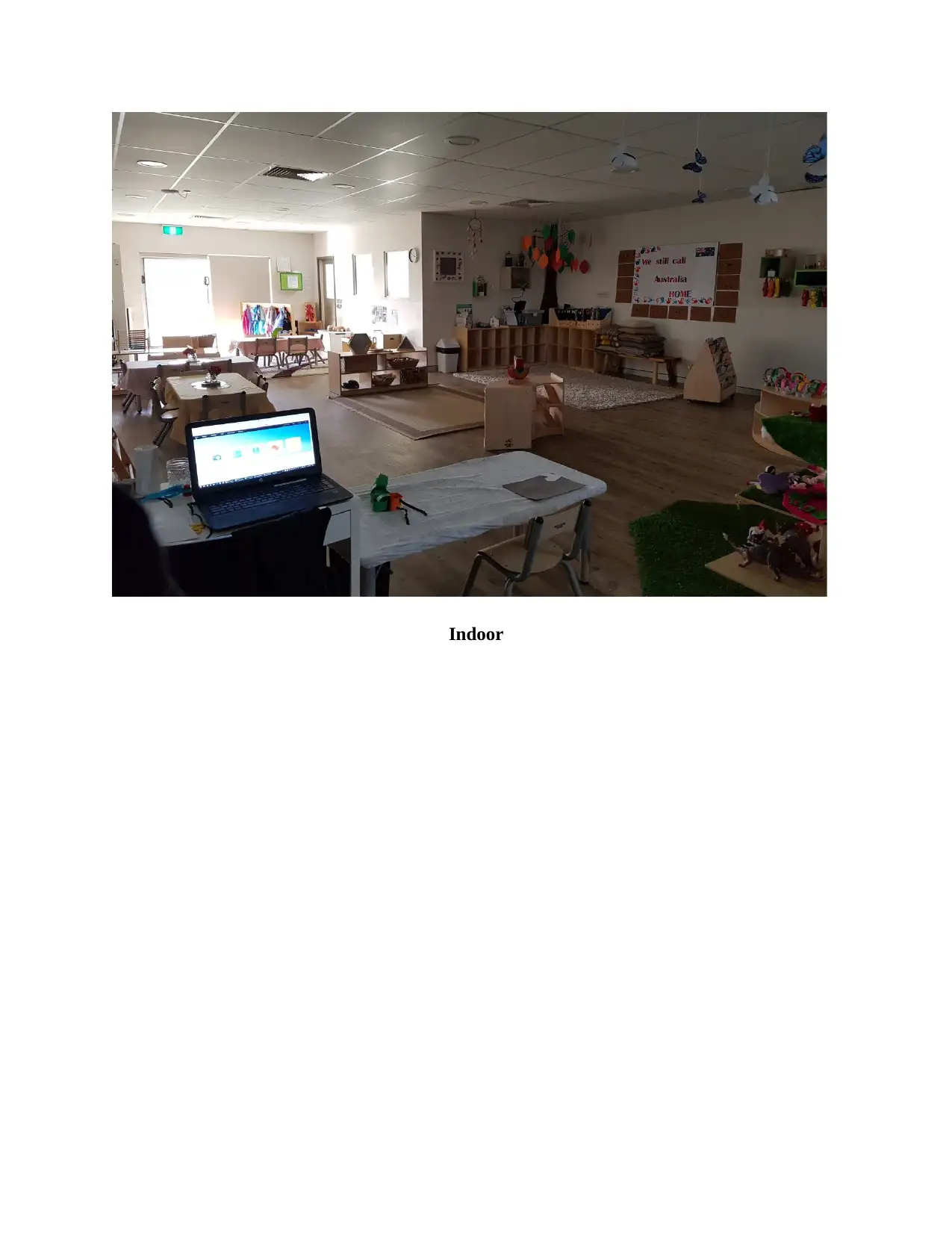
Indoor
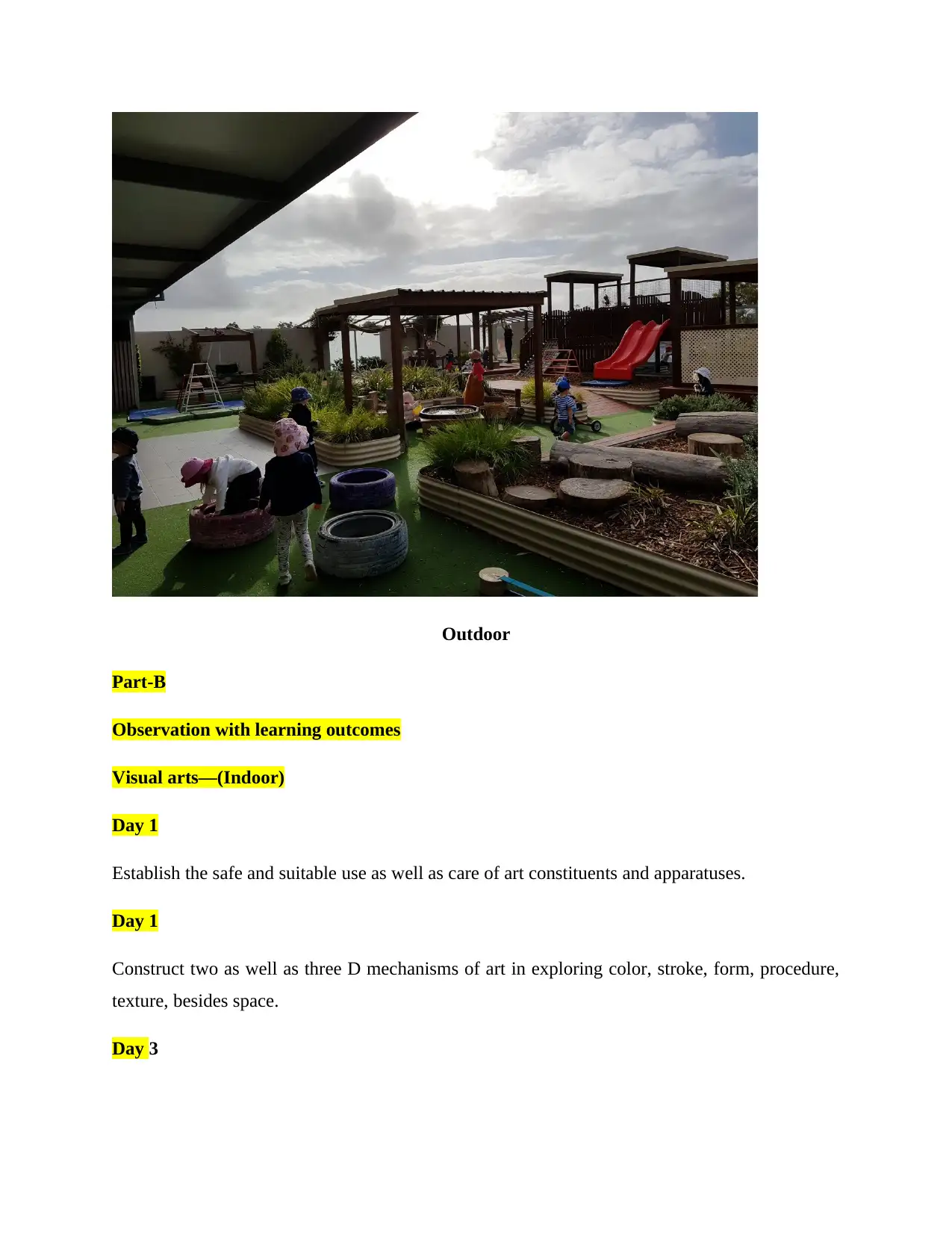
Outdoor
Part-B
Observation with learning outcomes
Visual arts—(Indoor)
Day 1
Establish the safe and suitable use as well as care of art constituents and apparatuses.
Day 1
Construct two as well as three D mechanisms of art in exploring color, stroke, form, procedure,
texture, besides space.
Day 3
Part-B
Observation with learning outcomes
Visual arts—(Indoor)
Day 1
Establish the safe and suitable use as well as care of art constituents and apparatuses.
Day 1
Construct two as well as three D mechanisms of art in exploring color, stroke, form, procedure,
texture, besides space.
Day 3
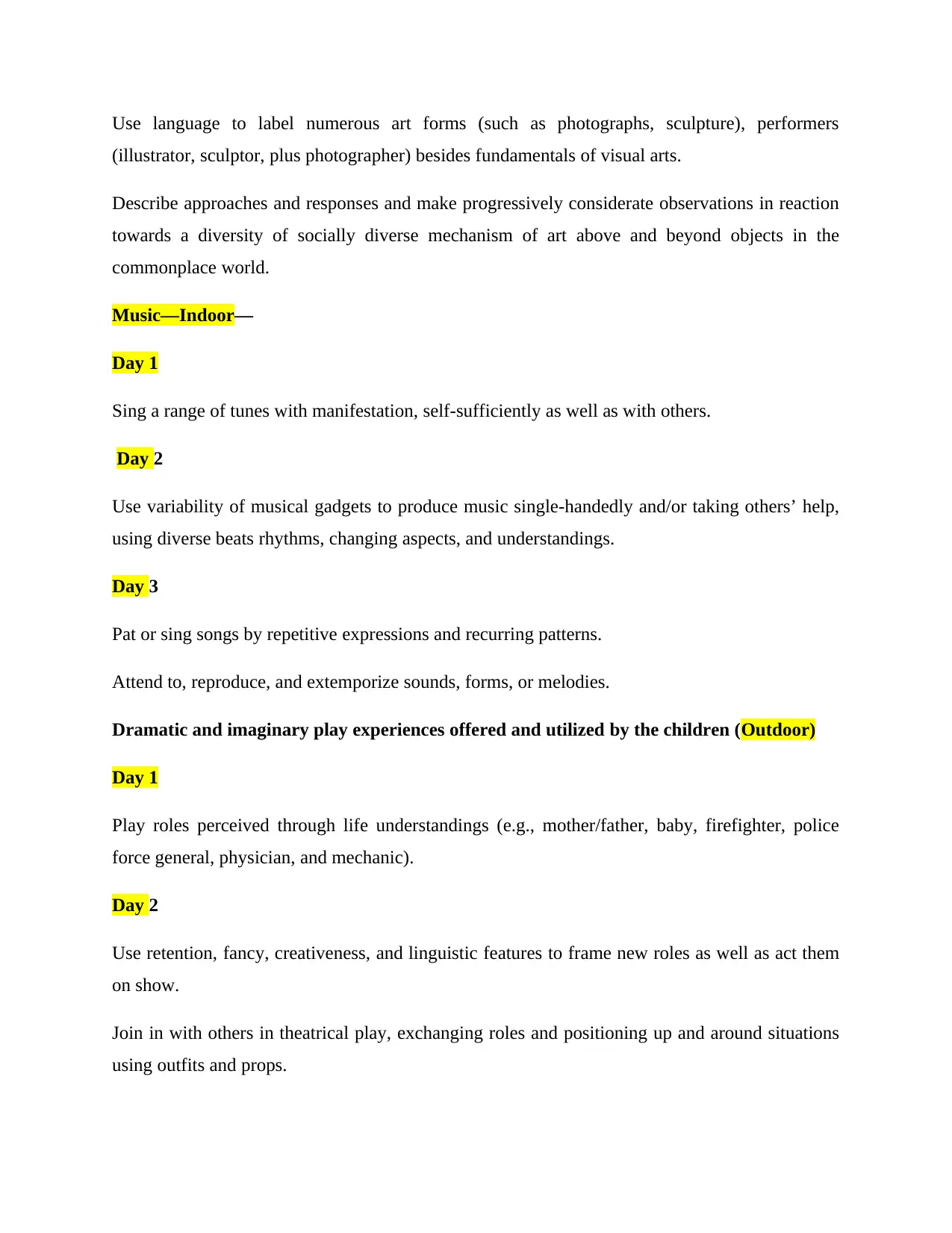
Use language to label numerous art forms (such as photographs, sculpture), performers
(illustrator, sculptor, plus photographer) besides fundamentals of visual arts.
Describe approaches and responses and make progressively considerate observations in reaction
towards a diversity of socially diverse mechanism of art above and beyond objects in the
commonplace world.
Music—Indoor—
Day 1
Sing a range of tunes with manifestation, self-sufficiently as well as with others.
Day 2
Use variability of musical gadgets to produce music single-handedly and/or taking others’ help,
using diverse beats rhythms, changing aspects, and understandings.
Day 3
Pat or sing songs by repetitive expressions and recurring patterns.
Attend to, reproduce, and extemporize sounds, forms, or melodies.
Dramatic and imaginary play experiences offered and utilized by the children (Outdoor)
Day 1
Play roles perceived through life understandings (e.g., mother/father, baby, firefighter, police
force general, physician, and mechanic).
Day 2
Use retention, fancy, creativeness, and linguistic features to frame new roles as well as act them
on show.
Join in with others in theatrical play, exchanging roles and positioning up and around situations
using outfits and props.
(illustrator, sculptor, plus photographer) besides fundamentals of visual arts.
Describe approaches and responses and make progressively considerate observations in reaction
towards a diversity of socially diverse mechanism of art above and beyond objects in the
commonplace world.
Music—Indoor—
Day 1
Sing a range of tunes with manifestation, self-sufficiently as well as with others.
Day 2
Use variability of musical gadgets to produce music single-handedly and/or taking others’ help,
using diverse beats rhythms, changing aspects, and understandings.
Day 3
Pat or sing songs by repetitive expressions and recurring patterns.
Attend to, reproduce, and extemporize sounds, forms, or melodies.
Dramatic and imaginary play experiences offered and utilized by the children (Outdoor)
Day 1
Play roles perceived through life understandings (e.g., mother/father, baby, firefighter, police
force general, physician, and mechanic).
Day 2
Use retention, fancy, creativeness, and linguistic features to frame new roles as well as act them
on show.
Join in with others in theatrical play, exchanging roles and positioning up and around situations
using outfits and props.
Secure Best Marks with AI Grader
Need help grading? Try our AI Grader for instant feedback on your assignments.
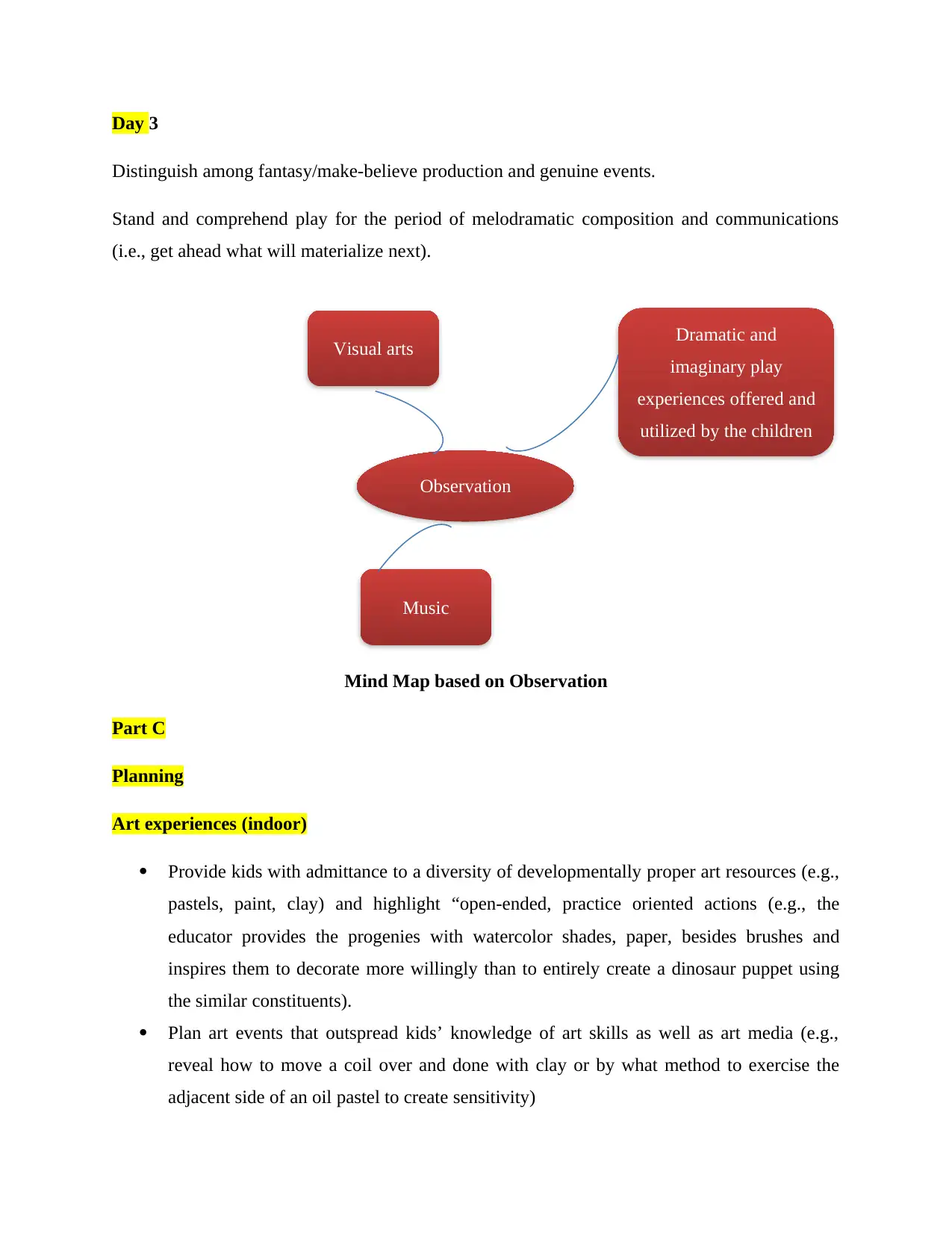
Day 3
Distinguish among fantasy/make-believe production and genuine events.
Stand and comprehend play for the period of melodramatic composition and communications
(i.e., get ahead what will materialize next).
Mind Map based on Observation
Part C
Planning
Art experiences (indoor)
Provide kids with admittance to a diversity of developmentally proper art resources (e.g.,
pastels, paint, clay) and highlight “open-ended, practice oriented actions (e.g., the
educator provides the progenies with watercolor shades, paper, besides brushes and
inspires them to decorate more willingly than to entirely create a dinosaur puppet using
the similar constituents).
Plan art events that outspread kids’ knowledge of art skills as well as art media (e.g.,
reveal how to move a coil over and done with clay or by what method to exercise the
adjacent side of an oil pastel to create sensitivity)
Observation
Visual arts Dramatic and
imaginary play
experiences offered and
utilized by the children
Music
Distinguish among fantasy/make-believe production and genuine events.
Stand and comprehend play for the period of melodramatic composition and communications
(i.e., get ahead what will materialize next).
Mind Map based on Observation
Part C
Planning
Art experiences (indoor)
Provide kids with admittance to a diversity of developmentally proper art resources (e.g.,
pastels, paint, clay) and highlight “open-ended, practice oriented actions (e.g., the
educator provides the progenies with watercolor shades, paper, besides brushes and
inspires them to decorate more willingly than to entirely create a dinosaur puppet using
the similar constituents).
Plan art events that outspread kids’ knowledge of art skills as well as art media (e.g.,
reveal how to move a coil over and done with clay or by what method to exercise the
adjacent side of an oil pastel to create sensitivity)
Observation
Visual arts Dramatic and
imaginary play
experiences offered and
utilized by the children
Music
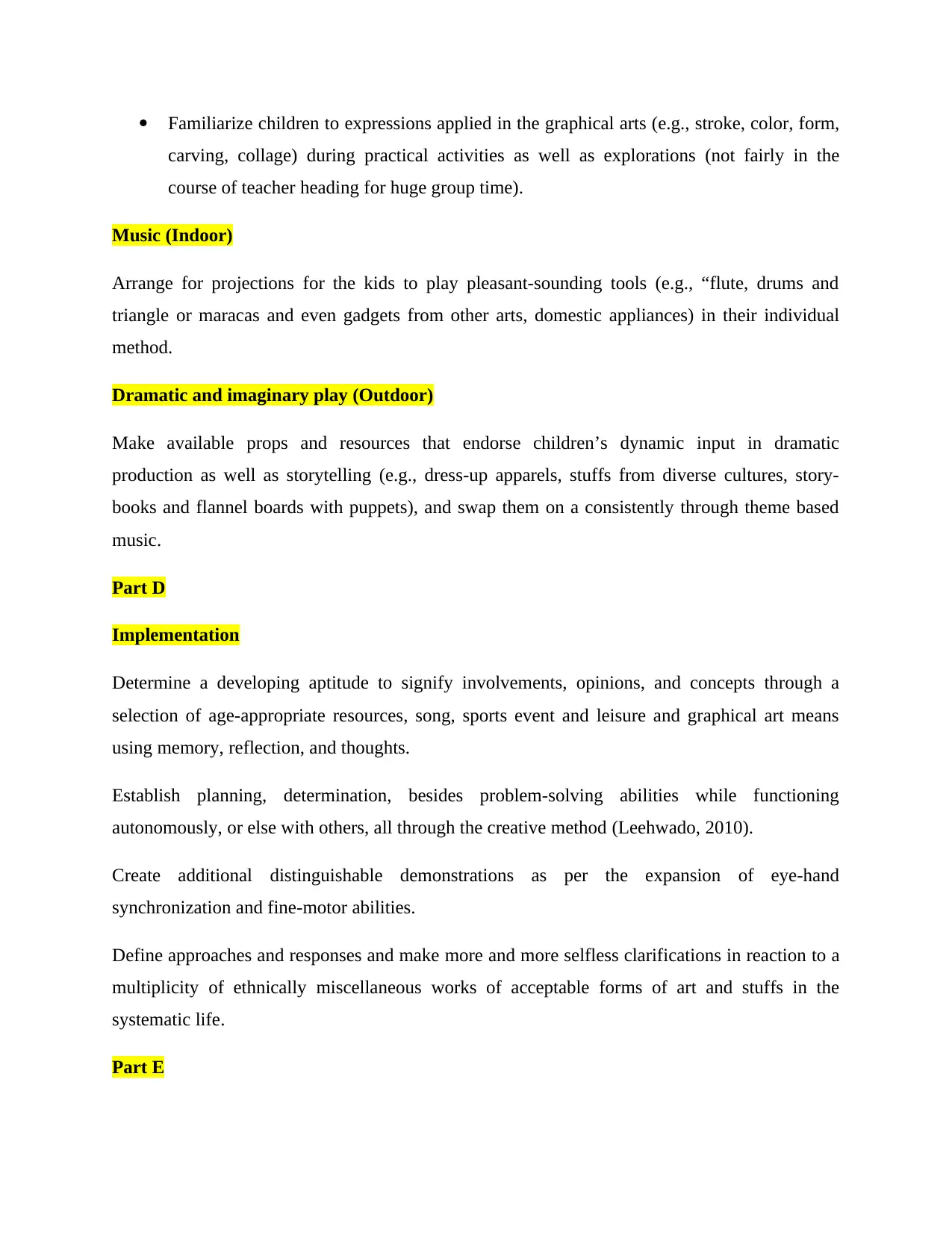
Familiarize children to expressions applied in the graphical arts (e.g., stroke, color, form,
carving, collage) during practical activities as well as explorations (not fairly in the
course of teacher heading for huge group time).
Music (Indoor)
Arrange for projections for the kids to play pleasant-sounding tools (e.g., “flute, drums and
triangle or maracas and even gadgets from other arts, domestic appliances) in their individual
method.
Dramatic and imaginary play (Outdoor)
Make available props and resources that endorse children’s dynamic input in dramatic
production as well as storytelling (e.g., dress-up apparels, stuffs from diverse cultures, story-
books and flannel boards with puppets), and swap them on a consistently through theme based
music.
Part D
Implementation
Determine a developing aptitude to signify involvements, opinions, and concepts through a
selection of age-appropriate resources, song, sports event and leisure and graphical art means
using memory, reflection, and thoughts.
Establish planning, determination, besides problem-solving abilities while functioning
autonomously, or else with others, all through the creative method (Leehwado, 2010).
Create additional distinguishable demonstrations as per the expansion of eye-hand
synchronization and fine-motor abilities.
Define approaches and responses and make more and more selfless clarifications in reaction to a
multiplicity of ethnically miscellaneous works of acceptable forms of art and stuffs in the
systematic life.
Part E
carving, collage) during practical activities as well as explorations (not fairly in the
course of teacher heading for huge group time).
Music (Indoor)
Arrange for projections for the kids to play pleasant-sounding tools (e.g., “flute, drums and
triangle or maracas and even gadgets from other arts, domestic appliances) in their individual
method.
Dramatic and imaginary play (Outdoor)
Make available props and resources that endorse children’s dynamic input in dramatic
production as well as storytelling (e.g., dress-up apparels, stuffs from diverse cultures, story-
books and flannel boards with puppets), and swap them on a consistently through theme based
music.
Part D
Implementation
Determine a developing aptitude to signify involvements, opinions, and concepts through a
selection of age-appropriate resources, song, sports event and leisure and graphical art means
using memory, reflection, and thoughts.
Establish planning, determination, besides problem-solving abilities while functioning
autonomously, or else with others, all through the creative method (Leehwado, 2010).
Create additional distinguishable demonstrations as per the expansion of eye-hand
synchronization and fine-motor abilities.
Define approaches and responses and make more and more selfless clarifications in reaction to a
multiplicity of ethnically miscellaneous works of acceptable forms of art and stuffs in the
systematic life.
Part E
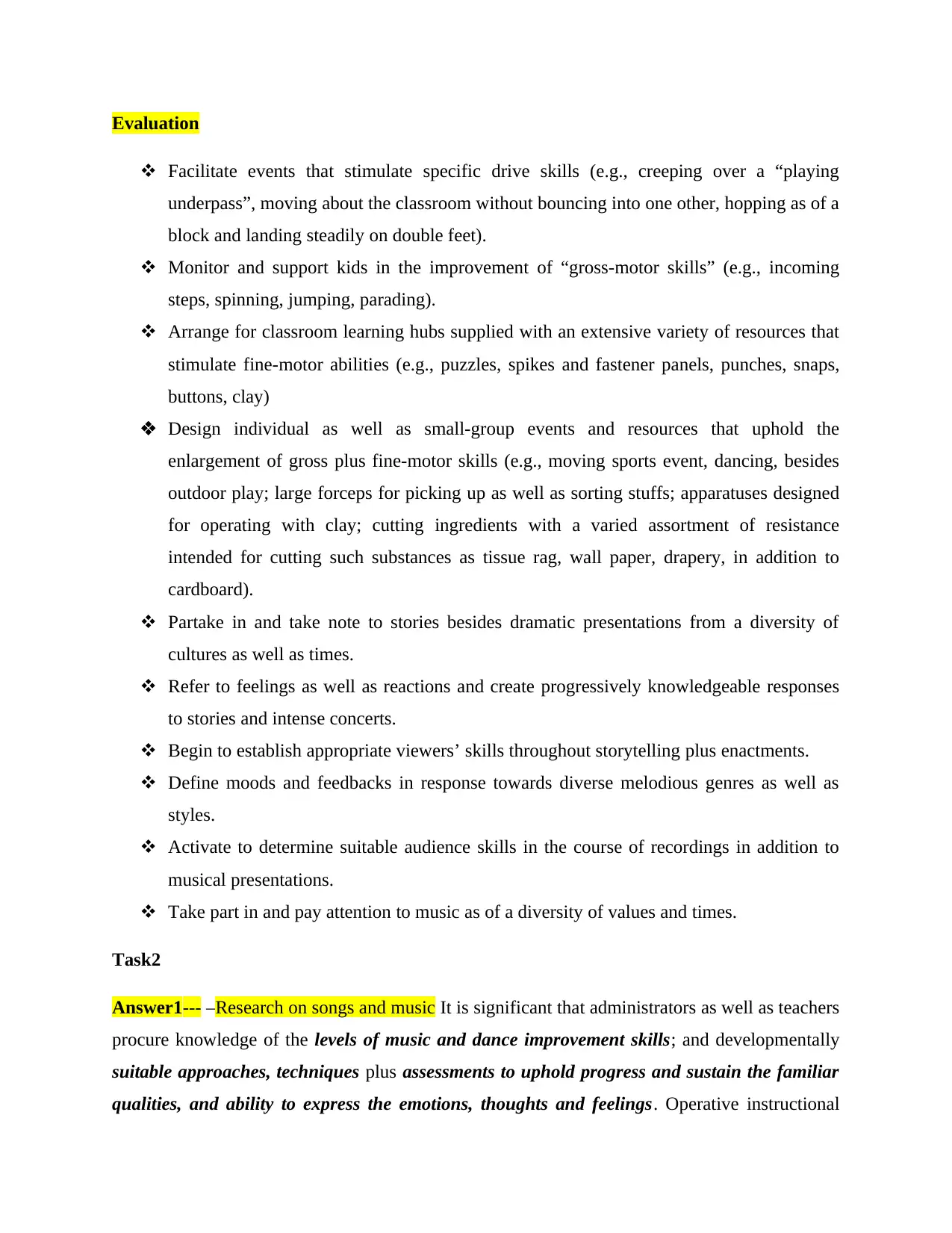
Evaluation
Facilitate events that stimulate specific drive skills (e.g., creeping over a “playing
underpass”, moving about the classroom without bouncing into one other, hopping as of a
block and landing steadily on double feet).
Monitor and support kids in the improvement of “gross-motor skills” (e.g., incoming
steps, spinning, jumping, parading).
Arrange for classroom learning hubs supplied with an extensive variety of resources that
stimulate fine-motor abilities (e.g., puzzles, spikes and fastener panels, punches, snaps,
buttons, clay)
Design individual as well as small-group events and resources that uphold the
enlargement of gross plus fine-motor skills (e.g., moving sports event, dancing, besides
outdoor play; large forceps for picking up as well as sorting stuffs; apparatuses designed
for operating with clay; cutting ingredients with a varied assortment of resistance
intended for cutting such substances as tissue rag, wall paper, drapery, in addition to
cardboard).
Partake in and take note to stories besides dramatic presentations from a diversity of
cultures as well as times.
Refer to feelings as well as reactions and create progressively knowledgeable responses
to stories and intense concerts.
Begin to establish appropriate viewers’ skills throughout storytelling plus enactments.
Define moods and feedbacks in response towards diverse melodious genres as well as
styles.
Activate to determine suitable audience skills in the course of recordings in addition to
musical presentations.
Take part in and pay attention to music as of a diversity of values and times.
Task2
Answer1--- –Research on songs and music It is significant that administrators as well as teachers
procure knowledge of the levels of music and dance improvement skills; and developmentally
suitable approaches, techniques plus assessments to uphold progress and sustain the familiar
qualities, and ability to express the emotions, thoughts and feelings. Operative instructional
Facilitate events that stimulate specific drive skills (e.g., creeping over a “playing
underpass”, moving about the classroom without bouncing into one other, hopping as of a
block and landing steadily on double feet).
Monitor and support kids in the improvement of “gross-motor skills” (e.g., incoming
steps, spinning, jumping, parading).
Arrange for classroom learning hubs supplied with an extensive variety of resources that
stimulate fine-motor abilities (e.g., puzzles, spikes and fastener panels, punches, snaps,
buttons, clay)
Design individual as well as small-group events and resources that uphold the
enlargement of gross plus fine-motor skills (e.g., moving sports event, dancing, besides
outdoor play; large forceps for picking up as well as sorting stuffs; apparatuses designed
for operating with clay; cutting ingredients with a varied assortment of resistance
intended for cutting such substances as tissue rag, wall paper, drapery, in addition to
cardboard).
Partake in and take note to stories besides dramatic presentations from a diversity of
cultures as well as times.
Refer to feelings as well as reactions and create progressively knowledgeable responses
to stories and intense concerts.
Begin to establish appropriate viewers’ skills throughout storytelling plus enactments.
Define moods and feedbacks in response towards diverse melodious genres as well as
styles.
Activate to determine suitable audience skills in the course of recordings in addition to
musical presentations.
Take part in and pay attention to music as of a diversity of values and times.
Task2
Answer1--- –Research on songs and music It is significant that administrators as well as teachers
procure knowledge of the levels of music and dance improvement skills; and developmentally
suitable approaches, techniques plus assessments to uphold progress and sustain the familiar
qualities, and ability to express the emotions, thoughts and feelings. Operative instructional
Paraphrase This Document
Need a fresh take? Get an instant paraphrase of this document with our AI Paraphraser
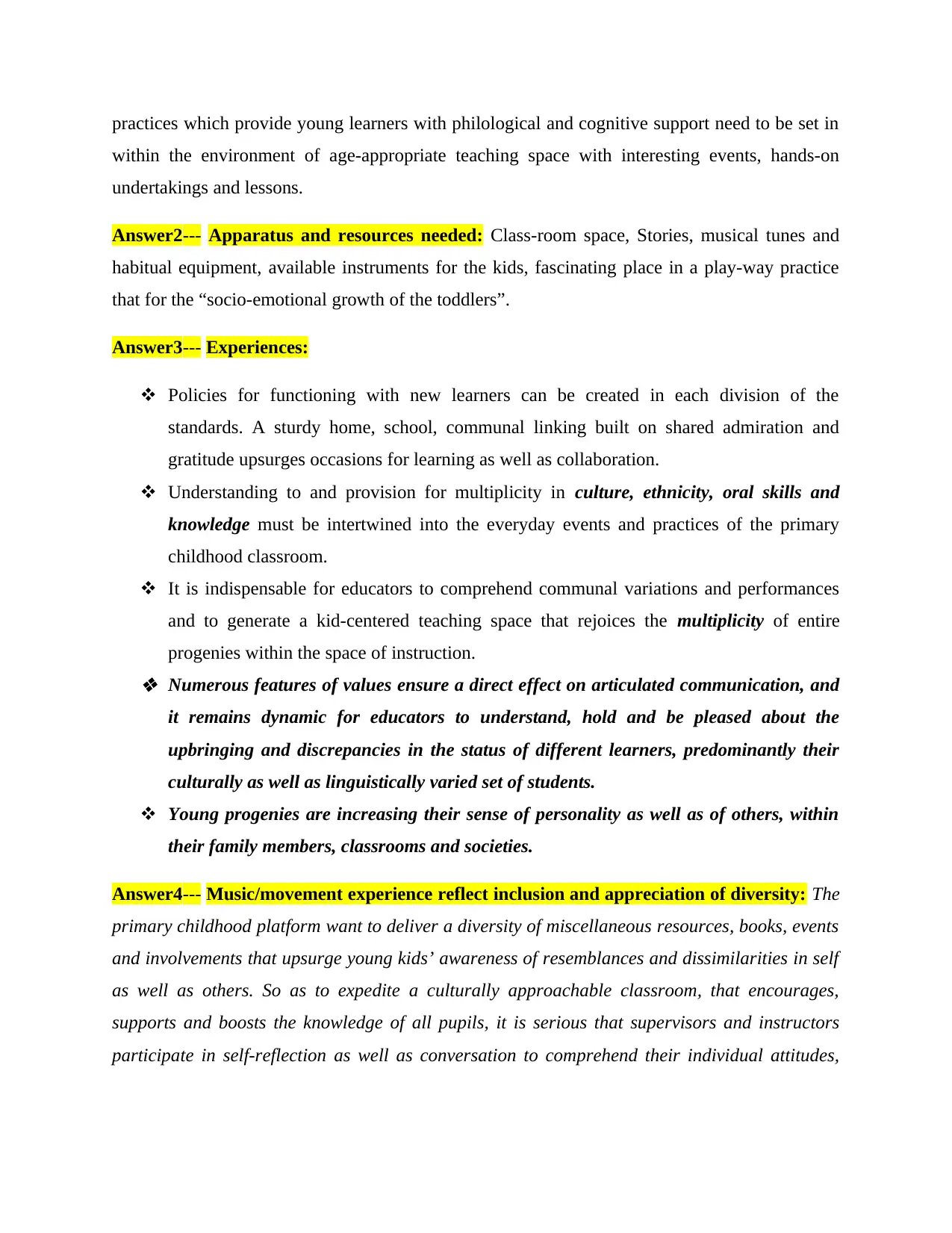
practices which provide young learners with philological and cognitive support need to be set in
within the environment of age-appropriate teaching space with interesting events, hands-on
undertakings and lessons.
Answer2--- Apparatus and resources needed: Class-room space, Stories, musical tunes and
habitual equipment, available instruments for the kids, fascinating place in a play-way practice
that for the “socio-emotional growth of the toddlers”.
Answer3--- Experiences:
Policies for functioning with new learners can be created in each division of the
standards. A sturdy home, school, communal linking built on shared admiration and
gratitude upsurges occasions for learning as well as collaboration.
Understanding to and provision for multiplicity in culture, ethnicity, oral skills and
knowledge must be intertwined into the everyday events and practices of the primary
childhood classroom.
It is indispensable for educators to comprehend communal variations and performances
and to generate a kid-centered teaching space that rejoices the multiplicity of entire
progenies within the space of instruction. Numerous features of values ensure a direct effect on articulated communication, and
it remains dynamic for educators to understand, hold and be pleased about the
upbringing and discrepancies in the status of different learners, predominantly their
culturally as well as linguistically varied set of students.
Young progenies are increasing their sense of personality as well as of others, within
their family members, classrooms and societies.
Answer4--- Music/movement experience reflect inclusion and appreciation of diversity: The
primary childhood platform want to deliver a diversity of miscellaneous resources, books, events
and involvements that upsurge young kids’ awareness of resemblances and dissimilarities in self
as well as others. So as to expedite a culturally approachable classroom, that encourages,
supports and boosts the knowledge of all pupils, it is serious that supervisors and instructors
participate in self-reflection as well as conversation to comprehend their individual attitudes,
within the environment of age-appropriate teaching space with interesting events, hands-on
undertakings and lessons.
Answer2--- Apparatus and resources needed: Class-room space, Stories, musical tunes and
habitual equipment, available instruments for the kids, fascinating place in a play-way practice
that for the “socio-emotional growth of the toddlers”.
Answer3--- Experiences:
Policies for functioning with new learners can be created in each division of the
standards. A sturdy home, school, communal linking built on shared admiration and
gratitude upsurges occasions for learning as well as collaboration.
Understanding to and provision for multiplicity in culture, ethnicity, oral skills and
knowledge must be intertwined into the everyday events and practices of the primary
childhood classroom.
It is indispensable for educators to comprehend communal variations and performances
and to generate a kid-centered teaching space that rejoices the multiplicity of entire
progenies within the space of instruction. Numerous features of values ensure a direct effect on articulated communication, and
it remains dynamic for educators to understand, hold and be pleased about the
upbringing and discrepancies in the status of different learners, predominantly their
culturally as well as linguistically varied set of students.
Young progenies are increasing their sense of personality as well as of others, within
their family members, classrooms and societies.
Answer4--- Music/movement experience reflect inclusion and appreciation of diversity: The
primary childhood platform want to deliver a diversity of miscellaneous resources, books, events
and involvements that upsurge young kids’ awareness of resemblances and dissimilarities in self
as well as others. So as to expedite a culturally approachable classroom, that encourages,
supports and boosts the knowledge of all pupils, it is serious that supervisors and instructors
participate in self-reflection as well as conversation to comprehend their individual attitudes,
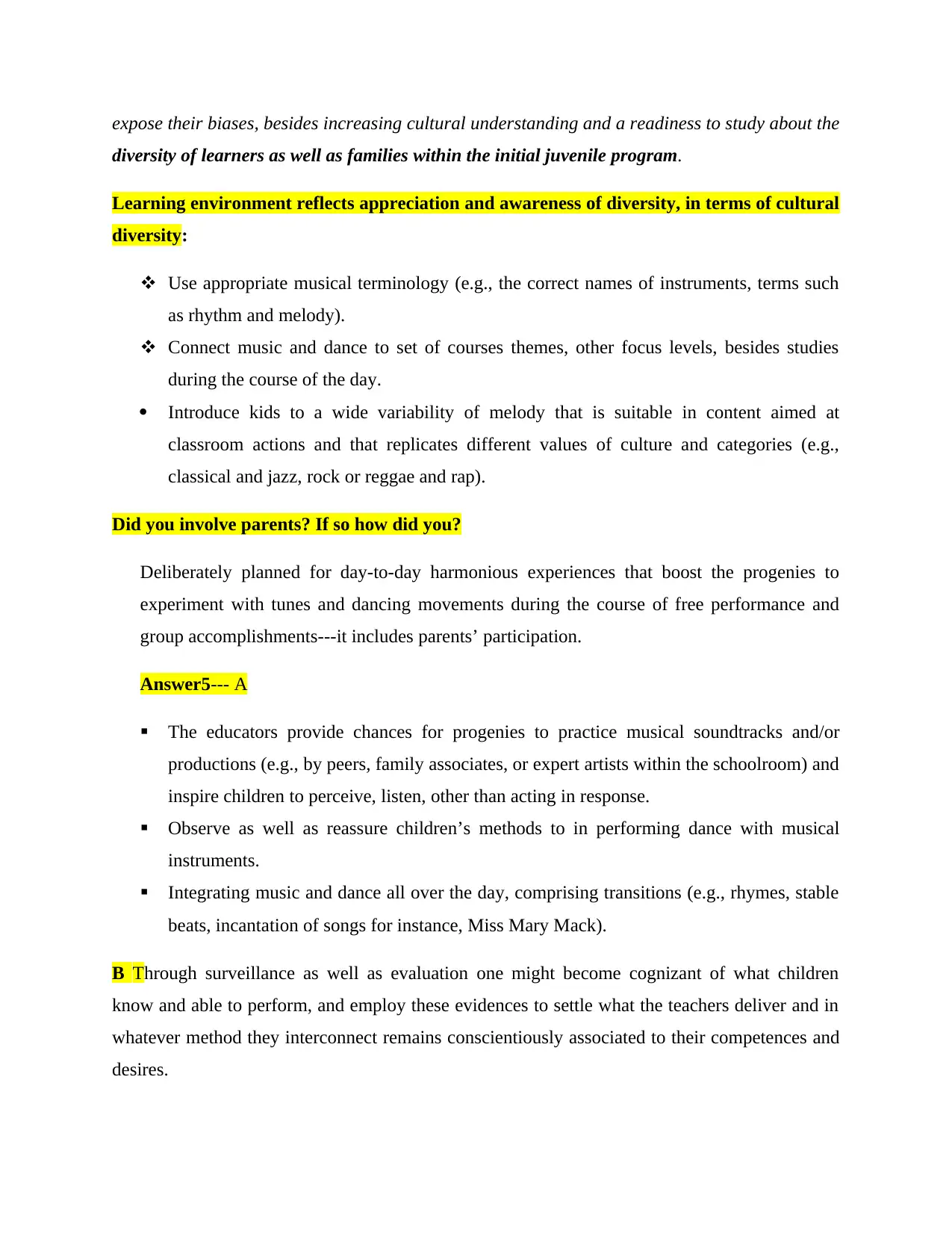
expose their biases, besides increasing cultural understanding and a readiness to study about the
diversity of learners as well as families within the initial juvenile program.
Learning environment reflects appreciation and awareness of diversity, in terms of cultural
diversity:
Use appropriate musical terminology (e.g., the correct names of instruments, terms such
as rhythm and melody).
Connect music and dance to set of courses themes, other focus levels, besides studies
during the course of the day.
Introduce kids to a wide variability of melody that is suitable in content aimed at
classroom actions and that replicates different values of culture and categories (e.g.,
classical and jazz, rock or reggae and rap).
Did you involve parents? If so how did you?
Deliberately planned for day-to-day harmonious experiences that boost the progenies to
experiment with tunes and dancing movements during the course of free performance and
group accomplishments---it includes parents’ participation.
Answer5--- A
The educators provide chances for progenies to practice musical soundtracks and/or
productions (e.g., by peers, family associates, or expert artists within the schoolroom) and
inspire children to perceive, listen, other than acting in response.
Observe as well as reassure children’s methods to in performing dance with musical
instruments.
Integrating music and dance all over the day, comprising transitions (e.g., rhymes, stable
beats, incantation of songs for instance, Miss Mary Mack).
B Through surveillance as well as evaluation one might become cognizant of what children
know and able to perform, and employ these evidences to settle what the teachers deliver and in
whatever method they interconnect remains conscientiously associated to their competences and
desires.
diversity of learners as well as families within the initial juvenile program.
Learning environment reflects appreciation and awareness of diversity, in terms of cultural
diversity:
Use appropriate musical terminology (e.g., the correct names of instruments, terms such
as rhythm and melody).
Connect music and dance to set of courses themes, other focus levels, besides studies
during the course of the day.
Introduce kids to a wide variability of melody that is suitable in content aimed at
classroom actions and that replicates different values of culture and categories (e.g.,
classical and jazz, rock or reggae and rap).
Did you involve parents? If so how did you?
Deliberately planned for day-to-day harmonious experiences that boost the progenies to
experiment with tunes and dancing movements during the course of free performance and
group accomplishments---it includes parents’ participation.
Answer5--- A
The educators provide chances for progenies to practice musical soundtracks and/or
productions (e.g., by peers, family associates, or expert artists within the schoolroom) and
inspire children to perceive, listen, other than acting in response.
Observe as well as reassure children’s methods to in performing dance with musical
instruments.
Integrating music and dance all over the day, comprising transitions (e.g., rhymes, stable
beats, incantation of songs for instance, Miss Mary Mack).
B Through surveillance as well as evaluation one might become cognizant of what children
know and able to perform, and employ these evidences to settle what the teachers deliver and in
whatever method they interconnect remains conscientiously associated to their competences and
desires.
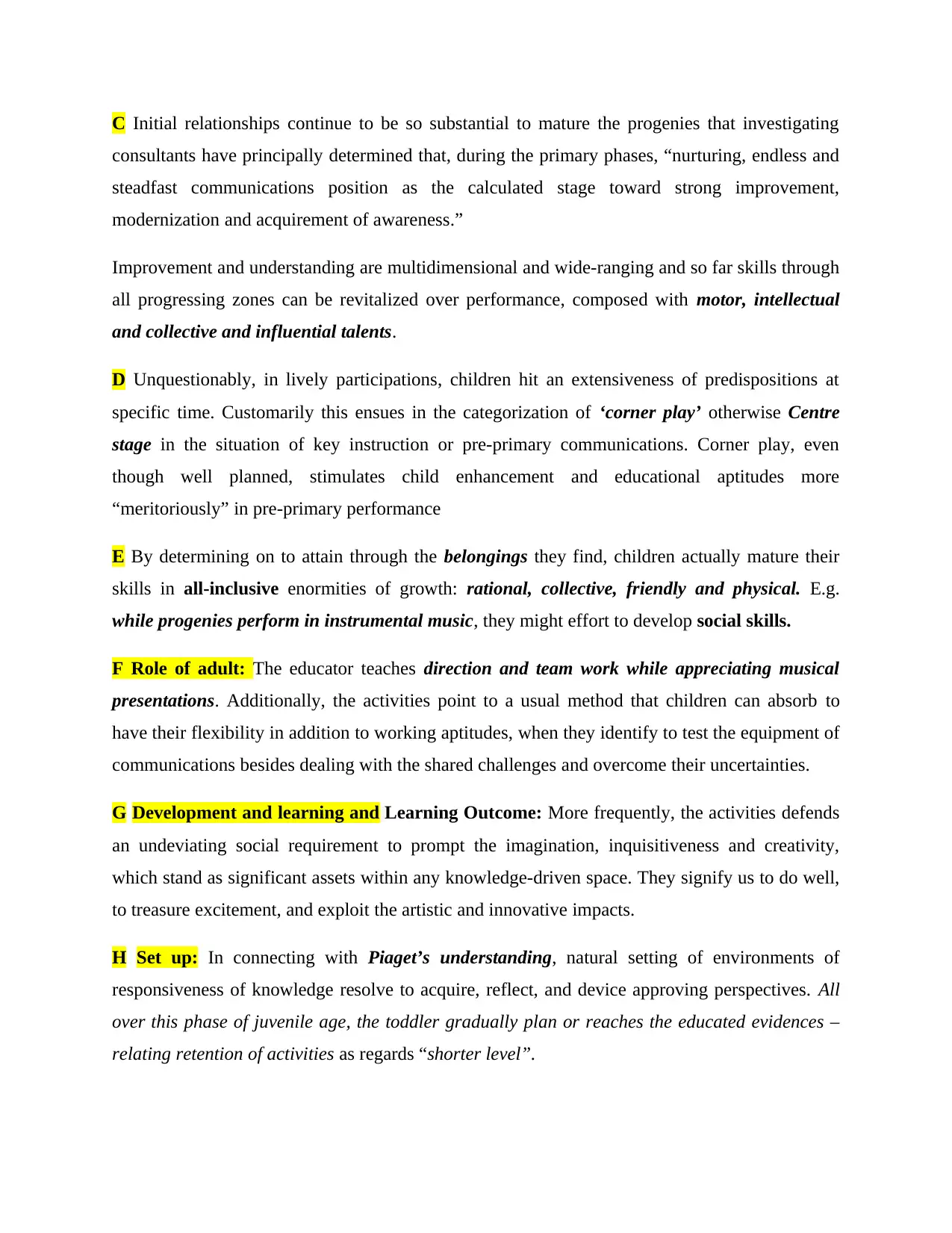
C Initial relationships continue to be so substantial to mature the progenies that investigating
consultants have principally determined that, during the primary phases, “nurturing, endless and
steadfast communications position as the calculated stage toward strong improvement,
modernization and acquirement of awareness.”
Improvement and understanding are multidimensional and wide-ranging and so far skills through
all progressing zones can be revitalized over performance, composed with motor, intellectual
and collective and influential talents.
D Unquestionably, in lively participations, children hit an extensiveness of predispositions at
specific time. Customarily this ensues in the categorization of ‘corner play’ otherwise Centre
stage in the situation of key instruction or pre-primary communications. Corner play, even
though well planned, stimulates child enhancement and educational aptitudes more
“meritoriously” in pre-primary performance
E By determining on to attain through the belongings they find, children actually mature their
skills in all-inclusive enormities of growth: rational, collective, friendly and physical. E.g.
while progenies perform in instrumental music, they might effort to develop social skills.
F Role of adult: The educator teaches direction and team work while appreciating musical
presentations. Additionally, the activities point to a usual method that children can absorb to
have their flexibility in addition to working aptitudes, when they identify to test the equipment of
communications besides dealing with the shared challenges and overcome their uncertainties.
G Development and learning and Learning Outcome: More frequently, the activities defends
an undeviating social requirement to prompt the imagination, inquisitiveness and creativity,
which stand as significant assets within any knowledge-driven space. They signify us to do well,
to treasure excitement, and exploit the artistic and innovative impacts.
H Set up: In connecting with Piaget’s understanding, natural setting of environments of
responsiveness of knowledge resolve to acquire, reflect, and device approving perspectives. All
over this phase of juvenile age, the toddler gradually plan or reaches the educated evidences –
relating retention of activities as regards “shorter level”.
consultants have principally determined that, during the primary phases, “nurturing, endless and
steadfast communications position as the calculated stage toward strong improvement,
modernization and acquirement of awareness.”
Improvement and understanding are multidimensional and wide-ranging and so far skills through
all progressing zones can be revitalized over performance, composed with motor, intellectual
and collective and influential talents.
D Unquestionably, in lively participations, children hit an extensiveness of predispositions at
specific time. Customarily this ensues in the categorization of ‘corner play’ otherwise Centre
stage in the situation of key instruction or pre-primary communications. Corner play, even
though well planned, stimulates child enhancement and educational aptitudes more
“meritoriously” in pre-primary performance
E By determining on to attain through the belongings they find, children actually mature their
skills in all-inclusive enormities of growth: rational, collective, friendly and physical. E.g.
while progenies perform in instrumental music, they might effort to develop social skills.
F Role of adult: The educator teaches direction and team work while appreciating musical
presentations. Additionally, the activities point to a usual method that children can absorb to
have their flexibility in addition to working aptitudes, when they identify to test the equipment of
communications besides dealing with the shared challenges and overcome their uncertainties.
G Development and learning and Learning Outcome: More frequently, the activities defends
an undeviating social requirement to prompt the imagination, inquisitiveness and creativity,
which stand as significant assets within any knowledge-driven space. They signify us to do well,
to treasure excitement, and exploit the artistic and innovative impacts.
H Set up: In connecting with Piaget’s understanding, natural setting of environments of
responsiveness of knowledge resolve to acquire, reflect, and device approving perspectives. All
over this phase of juvenile age, the toddler gradually plan or reaches the educated evidences –
relating retention of activities as regards “shorter level”.
Secure Best Marks with AI Grader
Need help grading? Try our AI Grader for instant feedback on your assignments.
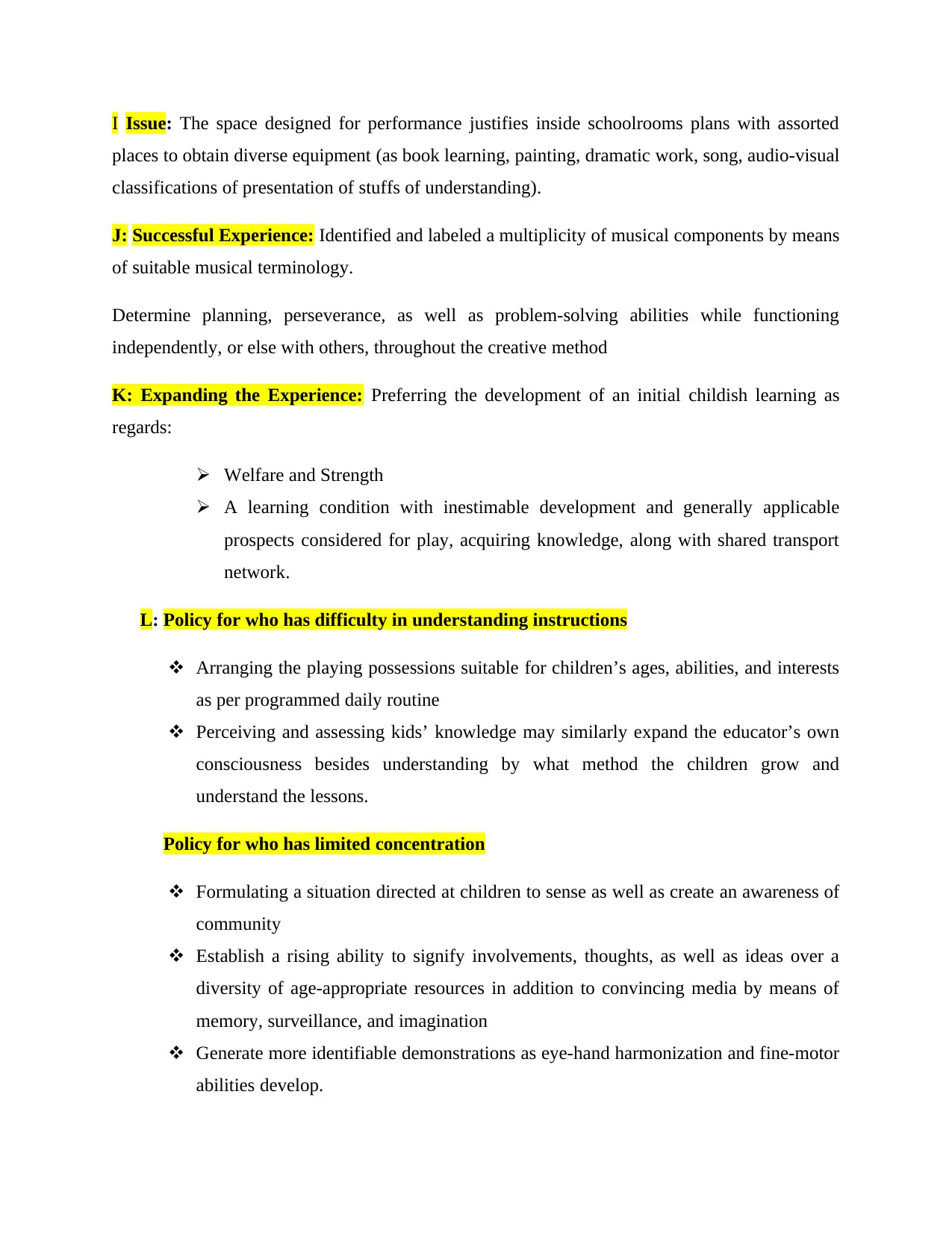
I Issue: The space designed for performance justifies inside schoolrooms plans with assorted
places to obtain diverse equipment (as book learning, painting, dramatic work, song, audio-visual
classifications of presentation of stuffs of understanding).
J: Successful Experience: Identified and labeled a multiplicity of musical components by means
of suitable musical terminology.
Determine planning, perseverance, as well as problem-solving abilities while functioning
independently, or else with others, throughout the creative method
K: Expanding the Experience: Preferring the development of an initial childish learning as
regards:
Welfare and Strength
A learning condition with inestimable development and generally applicable
prospects considered for play, acquiring knowledge, along with shared transport
network.
L: Policy for who has difficulty in understanding instructions
Arranging the playing possessions suitable for children’s ages, abilities, and interests
as per programmed daily routine
Perceiving and assessing kids’ knowledge may similarly expand the educator’s own
consciousness besides understanding by what method the children grow and
understand the lessons.
Policy for who has limited concentration
Formulating a situation directed at children to sense as well as create an awareness of
community
Establish a rising ability to signify involvements, thoughts, as well as ideas over a
diversity of age-appropriate resources in addition to convincing media by means of
memory, surveillance, and imagination
Generate more identifiable demonstrations as eye-hand harmonization and fine-motor
abilities develop.
places to obtain diverse equipment (as book learning, painting, dramatic work, song, audio-visual
classifications of presentation of stuffs of understanding).
J: Successful Experience: Identified and labeled a multiplicity of musical components by means
of suitable musical terminology.
Determine planning, perseverance, as well as problem-solving abilities while functioning
independently, or else with others, throughout the creative method
K: Expanding the Experience: Preferring the development of an initial childish learning as
regards:
Welfare and Strength
A learning condition with inestimable development and generally applicable
prospects considered for play, acquiring knowledge, along with shared transport
network.
L: Policy for who has difficulty in understanding instructions
Arranging the playing possessions suitable for children’s ages, abilities, and interests
as per programmed daily routine
Perceiving and assessing kids’ knowledge may similarly expand the educator’s own
consciousness besides understanding by what method the children grow and
understand the lessons.
Policy for who has limited concentration
Formulating a situation directed at children to sense as well as create an awareness of
community
Establish a rising ability to signify involvements, thoughts, as well as ideas over a
diversity of age-appropriate resources in addition to convincing media by means of
memory, surveillance, and imagination
Generate more identifiable demonstrations as eye-hand harmonization and fine-motor
abilities develop.

1 out of 12
Your All-in-One AI-Powered Toolkit for Academic Success.
+13062052269
info@desklib.com
Available 24*7 on WhatsApp / Email
![[object Object]](/_next/static/media/star-bottom.7253800d.svg)
Unlock your academic potential
© 2024 | Zucol Services PVT LTD | All rights reserved.

